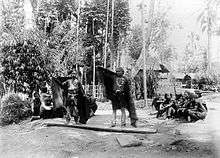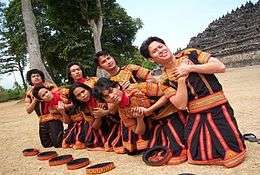Gayonese
|
A Gayonese bridegroom in traditional attire. | |
| Total population | |
|---|---|
| 336,856[1] | |
| Regions with significant populations | |
| Aceh, Indonesia | |
| Languages | |
| Gayo language | |
| Religion | |
| Islam | |
| Related ethnic groups | |
| Alas, Karo |
The Gayo people are an ethnic group living in the highlands of Aceh Province, Sumatra, Indonesia. The Gayo tribe has a population of 336,856 and they live predominantly in the mountains. Most Gayo live in three regencies in Aceh namely Bener Meriah, Central Aceh, and Gayo Lues. Some of them live in several districts in other regencies, such as Serbejadi District, Simpang Jernih District, and Peunaron District in East Aceh Regency and Beutong District in Nagan Raya Regency. Other than that, the Gayo population also covers Southeast Aceh Regency and Aceh Tamiang Regency.[2] Their homeland lies in the Barisan Mountains which has elevations of over 12,000 feet and extends more than one thousand miles. The Gayonese language has four dialects: Lut, Serbejadi-Lukup, Lut and Luwes. Their language does not have a writing system, but folk tales, stories and poetry are passed down in oral tradition. The traditional house of the Gayo is called Umah.
History
In the 11th century, the Linge Kingdom was established by the Gayo people during the reign of Sultan Makhdum Johan Berdaulat Mahmud Syah from the Perlak Sultanate, as it was told by two rulers who were ruling during the Dutch East Indies era; namely Raja Uyem and his son Raja Ranta, whom is Raja Cik Bebesen, and also Zainuddin from the rulers of Kejurun Bukit. Raja Linge I is said to have four children. The eldest was his daughter, Empu Beru or Datu Beru, and the remaining are Sebayak Lingga (Ali Syah), Meurah Johan (Johan Syah) and Meurah Lingga (Malamsyah). Sebayak Lingga wandered off to Karo land and founded a country there and he was known as Raja Lingga Sibayak. Meurah Johan ventured on to Aceh Besar and established his kingdom by the name of Lam Krak or Lam Oeii or also known as Lamuri or Lamuri Sultanate. This would mean that the Lamuri Sultanate was founded by Meurah Johan, while Meurah Lingga who was living in Linge, Gayo and the rest became kings of Linge for generations. Meurah Silu migrated to Pasai and became an officer to the Pasai Sultanate there. Meurah Mege himself was buried in Wih Ni Rayang at the slopes of Keramil Paluh in Linge, Central Aceh, which until today it can still be found and are considered sacred by the locals. The cause of migrating was unknown. However, according to history, Raja Linge favoured his youngest son, Meurah Mege, causing the rest of his children to prefer to wander away.[3]
Linga dynasty
- Adi Genali Raja Linge I in Gayo.
- Raja Sebayak Lingga became King of Karo in Karo land.
- Raja Meurah Johan, founded the Lamuri Sultanate.
- Meurah Silu, son of Meurah Sinabung, founded Samudera Pasai Sultanate.
- Raja Linge II also known as Marah Lingga in Gayo.
- Raja Lingga III to XII in Gayo.
- Raja Lingga XIII became Amir al-Harb of Aceh Sultanate. In 1533, the new Johor Empire was founded in pre-independence Malaysia led by Sultan Alauddin Mansyur Syah. Raja Lingga XIII was appointed to be in the cabinet of the new government. His descendants established the Lingga Sultanate in Lingga Island of the Riau Islands, and his sovereignty extended to Riau Province (Indonesia), Temasek (Singapore) and parts of Malaya (Malaysia).
No documentation were recorded on the rulers of Sebayak Lingga Karo. During the era of Dutch East Indies, the monarchy was appointed again but for two eras only.
- Raja Sendi Sibayak Lingga, as chosen by the Dutch East Indies.
- Raja Kalilong Sibayak Lingga
Dutch colonization

After initial Dutch resistance, which many Gayonese and Dutch were killed, the Dutch occupied the area during 1904–1942.[4] During this time, the Gayonese developed a thriving cash crop economy in vegetables and coffee. Since the Dutch colonization, the Gayonese have gained access to higher levels of education, and participated to some degree in the Islamization and modernization of their homeland.[5]
Surnames
Although it is not the practice of majority of Gayo society to have their surnames included, however there are a small group of them that still have their surnames attached to their given name especially those that are from Bebesen region. The purpose of the surname is only for them be identify and to be able to trace the individual's family lineage, thus it is not regarded as of great importance for the Gayo people. Gayo surnames are such as:-
- Ariga
- Cibero
- Linge
- Melala
- Munte
- Tebe
- Alga
- Uken
- Bukit
- Bukit eweh
- Bukit lah
- Jongok
- Gunung
- Kala
Culture
Religion
The Gayonese practise a local form of Islam. It is worth mentioning that the first Sultan of Aceh Darussalam was a Gayonese: Sultan Johan Alam Syah bin Adi Genali. In ancient times, the Gayonese believed in good and bad spirits and in holy men, both dead and alive. They would regularly give ritual offerings and sacrifices to the spirits, to holy men, and to their ancestors.[5]
Traditional dance and arts



- Didong[6]
- Didong Alo
- Didong Sesuk
- Didong Niet
- Tari Saman[7]
- Tari Bines[8]
- Tari Guel[9]
- Tari Munalo
- Tari Sining[10]
- Tari Turun ku Aih Aunen
- Tari Resam Berume[11]
- Tuah Kukur
- Melengkan
- Dabus[12]
Traditional cuisine
References
- ↑ Aris Ananta, Evi Nurvidya Arifin, M Sairi Hasbullah, Nur Budi Handayani & Agus Pramono (2015). Demography of Indonesia's Ethnicity. Institute of Southeast Asian Studies. p. 120. ISBN 981-4519-87-1.
- ↑ Muhammad Junus Melalatoa (2006). Memahami Aceh Sebuah Perspektif Budaya dalam Aceh. Aceh Kembali ke Masa Depan anthology, IKJ Press. p. 14. ISBN 979-3778-27-X.
- ↑ Muhammad Junus Djamil (1959). Gadjah Putih. Lembaga Kebudayaan Atjeh. OCLC 762157637.
- ↑ M.H. Gayo (1983). Perang Gayo-Alas Melawan Kolonial Belanda. Balai Pustaka. OCLC 568161081.
- 1 2 "Gayo in Indonesia". Joshua Project. Retrieved 2016-08-27.
- ↑ Dean Cycon (2007). Javatrekker: Dispatches from the World of Fair Trade Coffee. Chelsea Green Publishing. ISBN 1-933392-70-3.
- ↑ Arndt Graf, Susanne Schroter & Edwin Wieringa (2010). Aceh: History, Politics and Culture. Institute of Southeast Asian Studies. ISBN 981-4279-12-9.
- ↑ Darby Greenfield (1976). Indonesia: Java and Sumatra. Oleander Press. ISBN 978-0-902675-46-9.
- 1 2 John Richard Bowen (1993). Muslims Through Discourse: Religion and Ritual in Gayo Society. Princeton University Press. ISBN 0-691-02870-2.
- ↑ Muhammad Junus Melalatoa (1982). Kebudayaan Gayo. Balai Pustaka. OCLC 557829873.
- ↑ M. Affan Hasan, Thantawy R. & Kamaluddin M. (1980). Kesenian Gayo dan perkembangannya. Balai Pustaka. OCLC 7410608.
- ↑ Margaret J. Kartomi (2012). Musical Journeys in Sumatra. University of Illinois Press. ISBN 0-252-03671-9.
- 1 2 Domenyk Eades (2005). A Grammar of Gayo: A Language of Aceh, Sumatra. Research School of Pacific and Asian Studies, Australian National University. ISBN 0-85883-553-3.
- ↑ TimDapur Demedia (2008). Masakan Aceh. DeMedia. ISBN 979-1471-37-1.
Further reading
- Bowen, J. R., Sumatran Politics and Poetics: Gayo History, 1900–1989, Yale University Press, 1991 ISBN 978-0-300-04708-0
| Wikimedia Commons has media related to Gayo people. |